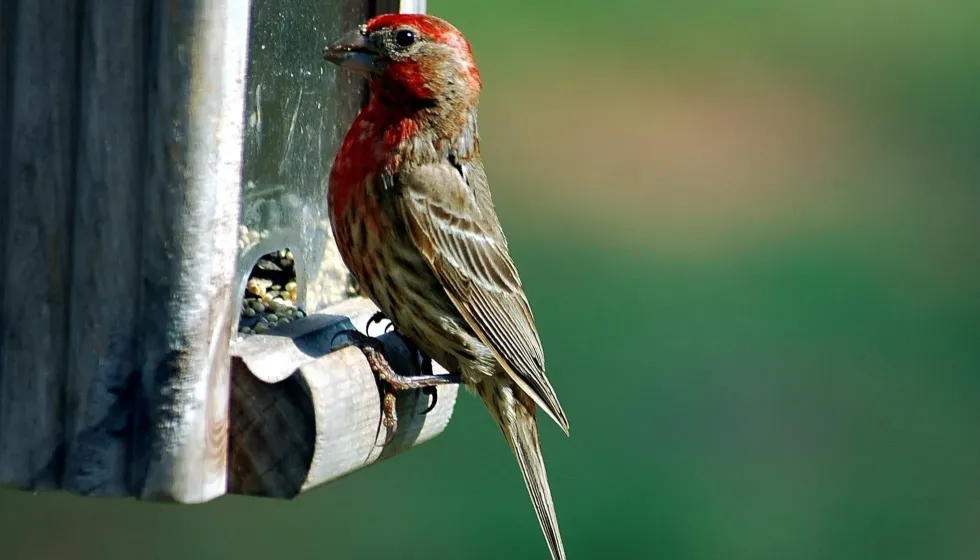Red-headed finches are a small-sized bird species found in parts of North America and in many southern African countries like Zimbabwe and South Africa.
These birds are famous because of their red heads, which only the male has, whereas females look totally different from males. Found mostly in temperate forests, brushy veldts, thorn-scrub habitats, villages, and farms, this bird's diet is completely herbivorous and it eats seeds, fruits, and food grains.
During the breeding season, the males attract the females by singing and bringing them food and then mate with the same partner for life. The female lays about three to six eggs in the nest every breeding season and is fed by the male.
This bird attains sexual maturity six months after they hatch from eggs.
Red-head finches are very friendly and enthusiastic birds and are known to be great choices for pets. These finches also symbolize a lot of things that can be known in this article, along with other interesting facts about this paradise finch.
If you liked reading about these facts about red-headed finches, you could also check out some facts on the European goldfinch and the Verdin.
Red-Headed Finch Interesting Facts
What type of animal is a red-headed finch?
Belonging to the class of Aves and kingdom Animalia, the red-headed finch (Amadina erythrocephala) is a bird species that is found in African countries like Angola and Namibia. These birds are quite common in the wild in south African countries and are also found in farms, villages, and even some urban areas.
What class of animal does a red-headed finch belong to?
The red-headed finch or the house finch belongs to the class of Aves and is a bird. These birds belong to the Estrildid family and Chordata phylum. The red-headed house finch is a common bird in southern Africa and is quite famous for its appearance, which has indeed helped it get so many other names for itself.
How many red-headed finches are there in the world?
These house finches have a worldwide extent of occurrence of about 617,763.5 sq miles (16,00,000 sq km). These birds are present in abundant numbers in the wild and are of Least Concern as of now.
The exact population of these birds across the globe is not known precisely, but their population is in good numbers and is known to be increasing over the years.
Where does a red-headed finch live?
This red-headed finch bird is found living in African countries and in a few parts of North America. These birds are found majorly in southern African countries like Angola, Lesotho, Zimbabwe, and South Africa. This house finch (red head), is also found living in farms, villages, and even some cities.
What is a red-headed finch's habitat?
House finches are known to be found in temperate forests, bushy veldts, and open thorn scrub habitats. Apart from this, as the diet of this bird consists of plants, fruits, grains, and seeds, these house finches are even seen in villages, farms, and even cities.
The house finch is known to build its nest on trees, but it's also seen building its nest on buildings too.
Who do red-headed finches live with?
House finches (red-head) are very social animals; it is rare to see them alone. They live in groups, and the breeding pair is known to be monogamous and stays and breeds together throughout the year.
House finches are not territorial birds and are generally seen moving and staying in small flocks and stay close to each other during the breeding season, and even build nests close to each other.
How long does a red-headed finch live?
The average lifespan of these house finches is about four to five years in the wild, but some house finches can live for about 11 years and seven months in the wild. This bird species does quite well in captivity too.
How do they reproduce?
Male finches are known to mark their territories and fight with other males for their territory during the breeding season. Meanwhile, females will be looking for potential males who bring them food, and males are known to attract females by singing the red-headed finch song.
This bird species is known to breed colonially, and the females lay eggs in nests that are abandoned, in building holes and tree cavities.
The female lays about three to six eggs once during the breeding season, and after an incubation period of about 13-14 days, the eggs hatch into small chicks.
The male feeds the female during and after incubation too for some days. The chicks fledge after a period of about three weeks and attain sexual maturity about six months after birth.
What is their conservation status?
The current conservation status of red-head finch birds is of Least Concern as they are present in great numbers worldwide. Their population is not known precisely, but it good enough as they are neither endangered nor a vulnerable bird species.
The only threats that this species of birds have are habitat loss and its predators like vultures and hawks in the wild.
Red-Headed Finch Fun Facts
What do red-headed finches look like?
Red-headed finches are found in red, white, brown, and gray colors. Males are rosy red on the face and breast region with black-brown belly and tails, whereas the females are not red but have a grayish-brown body and black tail and beaks.
These are small birds with short legs, sharp beaks, and beautiful wingspans and are most common in southern Africa.
How cute are they?
These birds that are found in North America and southern Africa are very cute and attractive. This species of bird is small in size with cute chirps and has an attractive and colorful body filled with feathers which makes it totally adorable.
How do they communicate?
The male is known to make a variety of sounds, like 'whee-ough', when courting or greeting a female. The males also make low 'err'-like sounds when they feel threatened by redheads. These birds often communicate by vocal sounds and chirps in different situations.
How big is a red-headed finch?
A red-headed finch has a weight of 0.6-0.8 oz (19-24 g) and a length of 6-7 in (14-17 cm). These finches are small birds and are about 10-12 times smaller than their main predator: vultures.
How fast can a red-headed finch fly?
The exact flying speed of these birds is not known, but their size and body structure help them to fly quite fast and quickly in the wild.
How much does a red-headed finch weigh?
A red-head finch is known to weigh around 0.6-0.8 oz (19-24 g).
What are their male and female names of the species?
There are no specific names for male or female birds of this species, but these birds are also called the red-headed weaver and the paradise finch. When it comes to scientific naming, these finches are referred to as Amadina erythrocephala.
What would you call a baby red-headed finch?
Baby red-head finches are called chicks once they hatch from the eggs.
What do they eat?
The red-head finch is a herbivore species of bird, and its diet includes plants, seeds, fruits, and grains. They are quite often seen in farms and villages as they feed on many food grains and other food items. These birds are generally hunted by bigger birds like vultures and hawks.
Are they dangerous?
No, these birds are very friendly and social birds and are known to be very pretty and amazing pets. These finches can fight amongst themselves but are very kind to humans.
Would they make a good pet?
Yes, red-headed finches are a great choice for pets as these birds are energetic, friendly, and do not take much space in the house. This red-headed finch is a small and enthusiastic bird that makes an amazing pet and, at the same time, will keep you entertained too.
Did you know...
Males (house finch) are 0.5 in (1.3 cm) taller than females.
The red-head finch and the cutthroat finch are closely related to the Melba finch.
The female redhead finch is similar to the more petite female of the cut-throat. It looks different because of its plain head and white tail.
Symbolism of the red-headed finch
The red-headed finch symbolizes a lot of positive things. When a person sees this common bird, it symbolizes liveliness, enthusiasm, and vitality in their life. This bird is a sparky signal of brighter days and higher energy on the horizon.
Red-headed finch vs. red-headed sparrow
Common red-headed finches are smaller than the red-headed sparrows and have shorter tails when compared to these sparrows. The tails of finches are narrower, and they do not flash their tails as frequently as the sparrows do.
Here at Kidadl, we have carefully created lots of interesting family-friendly animal facts for everyone to discover! Learn more about some other birds from our brant facts and grasshopper sparrow facts pages.
You can even occupy yourself at home by coloring in one of our free printable red-headed finch coloring pages.










